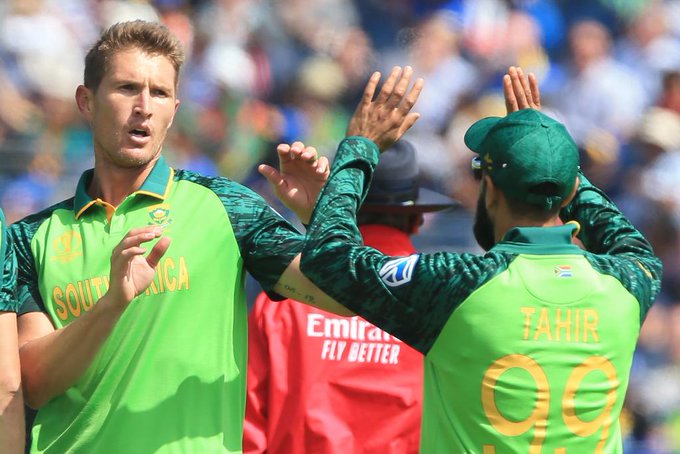Thankfully, South African cricket fans don’t have to go full into full meltdown mode and burn their Proteas shirts in public because while victory over Sri Lanka was a matter of too little too late, it at least lifted some of the gloom around a poor World Cup campaign, writes GARY LEMKE.
Now, after eight matches, they have a record which says two wins – over Afghanistan and Sri Lanka – with five defeats coming against England, Bangladesh, India, New Zealand and Pakistan and a rained-out game against West Indies. Still, their worst-ever return at a World Cup, but at least South Africa were allowed to stop the bleeding. That’s the ‘good’ news. The not-so-good news is that they play their last match of this 2019 tournament next Saturday against an Australian side that will be keen to rub sandpaper into the still raw wounds.
This was by no means a faultless performance at the Riverside Stadium despite the margin of their nine-wicket win. In fact, it was probably a ‘job done’ display against a team that was tipped to finish ninth out of 10 before the World Cup began. And, while one must applaud the South African performance, one has to add that in the two wins they’ve had at the event the one was against Afghanistan, having to chase 120 and the other against Sri Lanka, having to chase 200, and once they’d been eliminated from the tournament. With the pressure off.
Having said that, Hashim Amla and Faf du Plessis were clinical and classy in knocking off the 204 required for victory and they did so in 37.2 overs at a run rate of 5.51. Both players are simply too good to not be on the mentions list when it comes to World Cup moments and their unbeaten 175 for the second wicket is the fourth-highest partnership of the entire competition. Take a bow, gents.
Some might have said that the result was never in doubt from the moment Kagiso Rabada claimed the wicket of captain Dimuth Karunaratne with the first ball of the game.
It probably set the tone but this is a desperately poor Sri Lankan side, a pale shadow of that which won the 1996 World Cup. Rabada’s first-ball wicket was an innocuous 137km/h delivery that went straight on to the gloves and spooned up to Faf du Plessis in the slip area. From then on Kusal Perera and Avishka Fennando – both joint top-scored with 30 – made hay in the English sunshine, getting to 67 before Dwaine Pretorius claimed Fernando’s wicket with the penultimate delivery of the first 10-over powerplay.
And Sri Lanka suddenly resembled a sailing ship becalmed on a windless ocean. Only 24 runs came from their next 10 overs and they took 25 overs to double their score – from 67-1 after 10 to 134-5 after 35 overs – as Pretorius and Andile Phehlukwayo, with help from Chris Morris and Rabada, applied the slow poison, ruthlessly it might be added.
Sri Lanka’s batsmen were simply not equipped to get the scoreboard ticking on a pitch that looked to help the ‘dibbly-dobbler’ bowlers. It was a pitch that one could imagine former World Cup Hansie Cronje coming on and going through his 10 overs for twentysomething runs. But, credit where it’s due and after those free-scoring opening 10 overs South Africa pulled it back superbly.
However, Sri Lanka’s batsmen also contributed to their own downfall, and on their earlier visit to South Africa we saw them throwing their wickets away too cheaply and again they were generous in giving the opposition a look-in. Dananjaya de Silva inexplicably tried to reverse sweep JP Duminy’s first ball and was bowled, Karunaratne’s first-baller was a nothing shot, Fernando chose the wrong ball to try hit Pretorius over mid-on, while a couple of others played the wrong shot to the wrong ball and met their demise.
In reaching 203 all out, Sri Lanka’s batsmen never got going with high scores of 30, 30 24, 23, 21 and 20. And the 20 came from Mr Extras, which showed that for all the dominance the bowlers displayed from overs 10 to 40, they were also guilty of sending down 13 wides. Five of the six bowlers bowled wides – only Imran Tahir wasn’t guilty – and Rabada, Morris, Pretorius, Phehlukwayo and Duminy all got their lines wrong.
In taking three wickets Morris took his total for the World Cup to 12, the leading South African with only Mitchell Starc, Mohammad Amir, Jofra Archer, Lockie Ferguson and Mark Wood ahead of him in the most wickets column. Not bad for a ‘reserve’ who wasn’t in the original squad of 15.
However, it was Pretorius who changed the momentum of the Sri Lanka innings and brought the game under South Africa’s control. Jettisoned after the opening match defeat by England, where he in fact was slightly more economical with the ball than Rabada, Lungi Ngidi, Tahir and Duminy, he was impressive with 3-25 off 10 well-controlled and disciplined overs in his second match. He surely deserves to be in the starting XI against Australia, which ought to mean that the selectors should again leave out David Miller, but I wouldn’t bet against them recalling the left-handed batsman and rather dropping Duminy.
But, as they say in South Africa, ‘a win’s a win, ou pal’ and the Proteas will be relieved that they were better than at least two other teams at this World Cup, albeit being Sri Lanka and Afghanistan.







